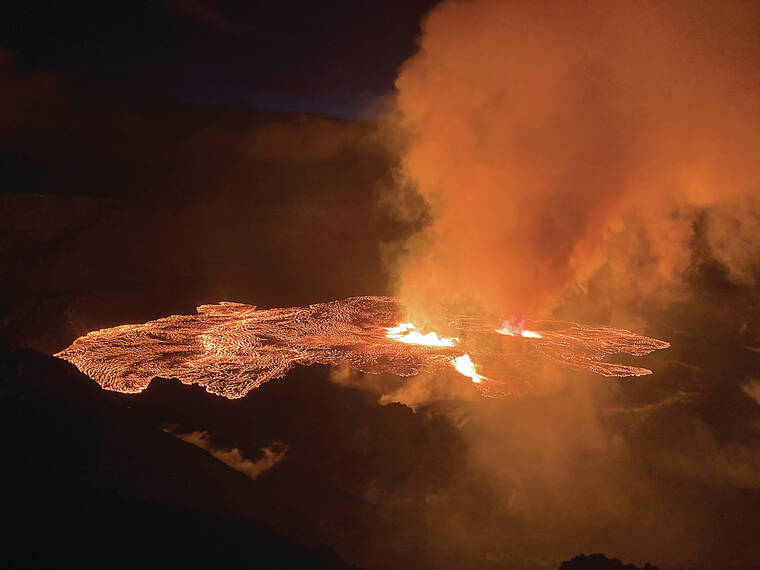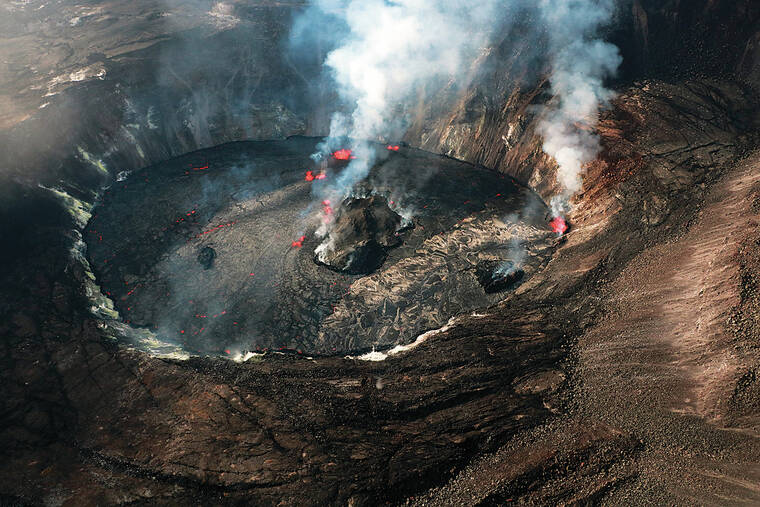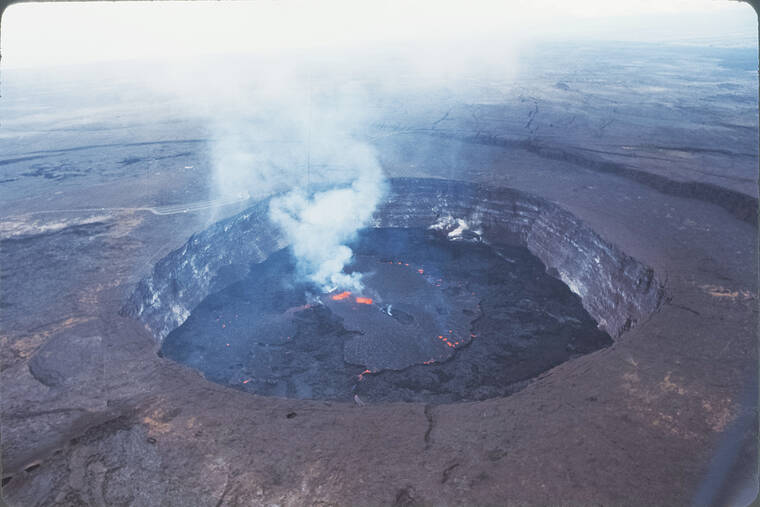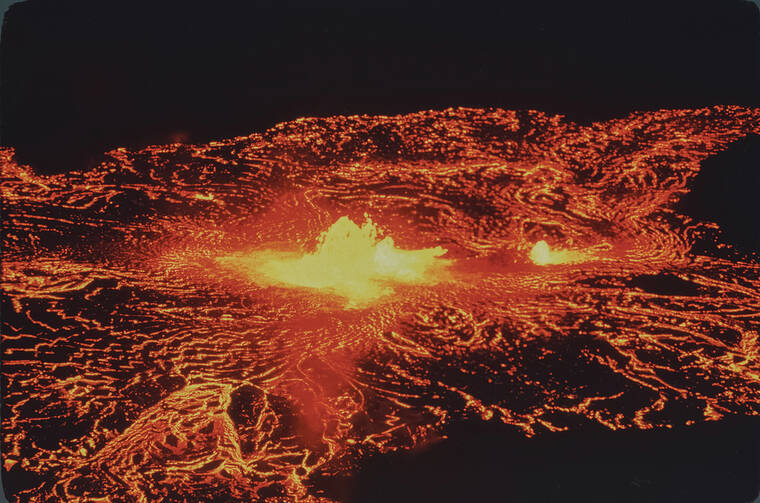Volcano Watch: Halema‘uma‘u’s 1967-68 eruption: another crater-filler
Kilauea’s activity from 2018 until now has been compared to cycles of summit collapse and refilling prior to 1924. However, Kilauea also exhibited similar behavior during the 1967-68 Halema‘uma‘u eruption.
We can learn about how the Hawaiian Volcano Observatory (HVO) monitored Kilauea prior to and during the 1967-68 Halema‘uma‘u eruption by reading reports documenting activity at that time. HVO staff then wrote, “The current eruption in Halema‘uma‘u is especially interesting because events seem to be following the same general pattern that was recorded again and again during the pre-1924 Kilauean activity.”
In March and December 1965, middle East Rift Zone eruptions occurred which partially drained the magma storage system at Kilauea summit and caused modest subsidence. The 2018 lower East Rift Zone eruption of Kilauea drained the summit magma chamber on a larger scale, resulting in caldera collapse.
Similar timeframes of quiet, non-eruptive periods ensued at the summit of Kilauea following the 1965 and 2018 eruptions. About two years after each eruption, the summit magma reservoir recharged and eruptions occurred.
HVO staff wrote that the 1967-68 eruption was preceded by only about “one hour of gradually increasing harmonic tremor … though the eruption has been ‘expected’ for over a year.” Gradually increasing earthquake rates and inflation over the months prior signaled to HVO staff that an eruption could be coming.
Likewise, modern HVO has monitored increasing rates of earthquakes and ground deformation for weeks to months prior to the recent eruptions at the summit of Kilauea. The immediate harbinger of these eruptions has occurred within a similar timeframe of about an hour, as ascending magma breaks rock and causes seismicity.
In 1967, HVO had 12 seismometers and two tiltmeters monitoring Kilauea’s summit. Though the seismometers were telemetered to the observatory, the tiltmeters were done by hand, being read manually every two to 12 hours.
Today, HVO’s Kilauea summit monitoring network includes similar numbers of seismometers (18) and tiltmeters (4), but it has expanded to include other monitoring datasets. For example, GPS stations record three-dimensional ground motion, gas stations record volcanic gas emissions and other meteorological data, gravimeters track accumulation and loss of magma beneath the surface, a laser rangefinder tracks elevation of the crater floor, and webcams capture imagery (visual and thermal) documenting changes on the surface and eruptive activity.
Compared to the manual data monitoring of 1967, telemetry advancements and digitization allow HVO scientists to observe near real-time monitoring data remotely. Much of these data are available to the public on the HVO website, including the popular livestream camera.
In their 1967 eruption reports, HVO staff observed that “Halema‘uma‘u is in the process of being filled.” The eruption, which began on November 5, 1967, went on for another 251 days and filled about 370 ft of lava in the crater (113 m). Post-2018 eruptions within Halema‘uma‘u, which began in December 2020, September 2021, January 2023, and June 2023, continued for two weeks to over a year, and have filled the crater over 1,270 feet (387 m) in total.
Tom Wright and Fred Klein, in their 2014 publication noted of HVO in the 1960-70s, “Along with improved instrumentation and methods came increased challenges to the HVO staff as eruption frequency underwent a dramatic increase.”
HVO staff today have seen similar improvements in monitoring and research, especially with funding supplied through the Additional Supplemental Appropriations for Disaster Relief Act of 2019 (H.R. 2157). Eruptions over the past several years, which include the several at Kilauea summit and one on Mauna Loa, have certainly kept HVO staff busy, but have also provided unprecedented opportunities for learning and strengthening relationships with our partners and communities on the island of Hawaii.
Similarities can be drawn between Kilauea’s behavior prior to 1924 and discrete other periods, including the 1967-68 eruption and the 2018 summit collapse and subsequent refilling eruptions. These examples are a good reminder that a volcano’s past behavior can offer clues as to how it might behave in the future.
Volcano Activity Updates
Kilauea is not erupting. Its USGS Volcano Alert level is ADVISORY.
Active lava has not been visible within Halema’uma’u crater at the summit of Kilauea since June 19. Earthquake activity in the summit region has been low over the past week. Summit tiltmeters generally showed gradual inflation for much of the past week. A sulfur dioxide (SO2) emission rate of approximately 104 tonnes per day was measured on July 17.
Mauna Loa is not erupting. Its USGS Volcano Alert Level is at NORMAL.
Webcams show no signs of activity on Mauna Loa. Seismicity remains low. Summit ground deformation rates indicate slow inflation as magma replenishes the reservoir system following the recent eruption. SO2 emission rates are at background levels.
There were five earthquake with three or more felt reports in the Hawaiian Islands during the past week: a M3.2 earthquake 21 km (13 mi) N of Hawaiian Ocean View at -1 km (0 mi) depth on July 18 at 11:24 p.m. HST, a M3.2 earthquake 10.1 km (6.2 mi) NE of Pahala at 31 km (19 mi) depth on July 16 at 12:56 a.m. HST, a M3.0 earthquake 12 km (7 mi) N of Puako at 20 km (12 mi) depth on July 13 at 7:56 p.m. HST, a M1.8 earthquake 14 km (8 mi) ESE of Pahala at 31 km (19 mi) depth on July 13 at 12:38 p.m. HST, and a M4.6 earthquake 97 km (60 mi) NNE of Laupahoehoe at 28 km (17 mi) depth on July 13 at 11:29 a.m. HST.
HVO continues to closely monitor Kilauea and Mauna Loa.
Please visit HVO’s website for past Volcano Watch articles, Kilauea and Mauna Loa updates, volcano photos, maps, recent earthquake information, and more. Email questions to askHVO@usgs.gov.
Volcano Watch is a weekly article and activity update written by U.S. Geological Survey Hawaiian Volcano Observatory scientists and affiliates.





